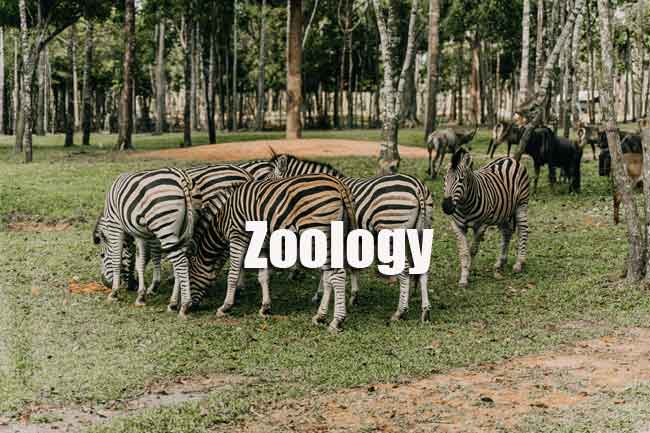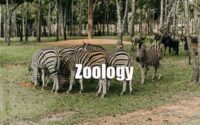Zoology Easy Question Papers
In this Article, we have provided the Zoology Easy Question Papers along with Solutions. So, the interested candidates who applied for jobs in Zoology can download Zoology Easy Question Papers for free of cost. Get all the Zoology Easy Question Papers with just one click. Click on the enclosed links below to download the Zoology Easy Question Papers.

Check the Last five years Zoology Easy Question Papers to get a clear idea of the exam pattern. Along with Zoology Easy Question Papers, it’s better to refer Zoology Syllabus & Exam Pattern before starting preparation. So, click on link to check and download Zoology Easy Question Papers PDF.
Easy Question Papers of Zoology
1. Which one of them is not interact with cell surface receptor ?
(1) Gastrin
(2) Glucagon
(3) Testosterone
(4) Insulin
2. Which one of them G-protein regulate the growth of the cell?
(1) Rho
(2) Ras
(3) Ran
(4) Rab
3. Chemical signalling is performed by
(1) Autocrine signalling
(2) Synaptic transmission
(3) Paracrine signalling
(4) Autostimulation
4. Which one of them is incorrect statement about G protein ?
(1) G proteins become activated when bound to GDP.
(2) Guanine nucleotides regulate G proteins.
(3) G proteins are involved in signal cascades.
(4) All of these
5. Which one of the following is not a functional protein?
(1) Keratin
(2) Urease ag
(3) Amylase Loa
(4) Invertase
6. Variable which can be expresser numerically are called
(1) Continuous variable
(2) Quantitative variable
(3) Qualitative variable
(4) Absolute variable
7. Colour of animal is
(1) Continuous variable
(2) Absolute variable
(3) Qualitative variable
(4) Quantitative variable
8. The most common plasmid vector used in genetic engineering is
(1) pBR3825
(2) pBR328
(3) pBR322
(4) pBR335
9. H2O2 degrading enzyme is
(1) Lipases
(2) Succinate dehydrogenase
(3) Catalase
(4) Glutathione succinate cyclase
10. Which enzyme acts on PIP2 and produces IP3 and DAG ?
(1) Protein kinase C
(2) Adenylyl cyclase
(3) Phospholipase C
(4) Kinases
11. The Chloroplast DNA is
(1) Like the nuclear DNA
(2) Single stranded linear
(3) Double stranded circular
(4) Single stranded circular
12. Which one of them is serving as secondary messenger ?
(1) Protein kinase A
(2) Ion channel
(3) Cyclic AMP
(4) GABA
13. Association of two species depend upon each other is known as
(1) Parasitism
(2) Commensalism
(3) Mutualism
(4) Symbiosis
14. Which one of them is receiving the maximum energy in energy flow ?
(1) Primary consumer
(2) Secondary consumer
(3) Tertiary consumer
(4) Producers
15. The association of algae and fungi in lichen is describing by
(1) Parasitism
(2) Symbiosis
(3) Mutualism
(4) Commensalism
16. An ecological niche normally occupied by
(1) A small community
(2) Fast growing species
(3) Competing species
(4) None of these
17. Which one of them ecosystem has lowest production ?
(1) Shallow ocean
(2) Grassland
(3) Deep oceans
(4) Moist forest
18. The area where two ecosystems meet and blend each other is known as
(1) Niche
(2) Edge effect
(3) Ecotone
(4) Ecotype
19. All living organisms of earth constitute
(1) Biome
(2) Biosphere
(3) Community
(4) Association
20. Bhopal Gas tragedy caused by leakage of
(1) Isocyanic acid
(2) Isopropyl thiocyanate
(3) Methyl isocyanate
(4) Chlorofluorocarbon
| Hard Questions | GK |
| Easy Questions | Quiz |
| Important Questions | Viva |
| TRB | MCQs |
| GATE | Sample Papers |
| JRF | Model Questions |
| NEET | Previous Papers |
| Objective |
21. Minamata disease caused by pollution of water by
(1) Copper isocyanides
(2) Zink
(3) Mercury
(4) Oil spill out in sea
22. Species that causéd by Geographical isolation is known as
(1) Sympatric
(2) Allopatric
(3) Heteropatric
(4) Geopatric
23. Bottom dwelling animals are known as .
(1) Arboreal
(2) Gigantic
(3) Benthos
(4) Bottom philopatric
24. When was the UNESCO launched “Human and the Biosphere” program ?
(1) 1981
(2) 1971
(3) 1975
(4) 1983
25. The term biocenosis given by
(1) Karl Mobius
(2) T.N. Huxley
(3) M.P.N. Thumbaville
(4) T. Rajan Viravallie
26. Which of the following are enzymes ?
(1) Gastrin, Lipase & Trypsin
(2) Renin, Trypsin & Amylopsin
(3) Enterokinase, Lipase & Trypsin
(4) Pepsin, Lipase & Trypsin
27. Which one of them is nobel prize winner in the field of enzyme discovery ?
(1) Buchner
(2) Flemming
(3) Altman
(4) Alexander
28. Which one of the following vein has minimum amount of urea ?
(1) Hepatic portal vein
(2) Pulmonary vein
(3) Renal vein
(4) Hepatic extra portal vein
29. Ratio of leukocytes and red blood cells in human blood is
(1) 1: 200
(2) 1: 150
(3) 2: 350
(4) 1: 500
30. If haemoglobin replaced by hemocyanin then the blood will carry
(1) More oxygen
(2) Less oxygen
(3) No change
(4) Equal oxygen
31. Chordae tendinae is occurs in
(1) Truncus arteriosus
(2) Ventricles of heart
(3) Vein
(4) Auricles wall
32. Trilobed valve occur between right atrium and ventricle in mammalian heart is
(1) Semi-lunar valve
(2) Bicuspid valve
(3) Tricuspid valve
(4) None of these
33. The part of neurons that perform basic cellular functions, such as protein synthesis are the
(1) Dentrites
(2) Axon
(3) Somas
(4) Synaptic knobs
34. Meissner’s corpuscles are found in a
(1) Liver ms
(2) Pancreatic acinies
(3) Skin
(4) Neurons
35. Jacobson’s organ in amphibia is known as
(1) Gastrointestinal plexus
(2) Temporal brain axis
(3) Vemero-nasal organ
(4) Testicular epidydimal plexus
36. Nocturnal animals have
(1) Cones cells are more
(2) Rods cells are more
(3) Cones cells are absent
(4) Equal numbers of cones and rod cells
37. Hearing is better in rabbit than frog due to
(1) Three semi-circular canals
(2) Tympanic membrane
(3) Movable pinna
(4) Fenestra ovalis
38. Philadelfia chromosome is found in the patients suffering from
(1) Leukaemia
(2) Colour-blindness
(3) Gastrointestinal diseases
(4) Pellagra
39. Mitotic apparatus consisting of
(1) Spindle fibre
(2) Astral rays
(3) Centriole
(4) All of these
40. Which one of them has absence of DNA content ?
(1) Mitochondria
(2) Tobacco Mosaic Virus
(3) Bacteriophage virus
(4) Chloroplast
41. Which one of these phase longest in interphase ?
(1) Synthetic Phase
(2) G, (first gap period)
(3) G, (second gap period)
(4) All of these are of same duration.
42. The G1 phase of the cell cycle is describing that
(1) m-RNA synthesis
(2) Cytoplasm division
(3) Maximum growth of cell
(4) Cytoplasmic splitting
43. The functional unit of DNA is
(1) Deoxyribose sugar
(2) Purine
(3) Pyrimidine
(4) Cistron
44. Genes are
(1) Histone molecules created structure
(2) Lipoprotein
(3) Polynucleotide
(4) Glycoprotein and histones
45. The concept of interferons given by
(1) Paulberg and Jakobson
(2) Morgan and Knoll
(3) Isaac and Lindenmann
(4) Wilson and Walker
46. Thalassemia is caused by
(1) Point mutation
(2) Autosomal dominance
(3) Gross mutation
(4) Autosomal recessive
47. Resolving power of Scanning Electron Microscopy (SEM) is
(1) .2 nm
(2) .1 nm
(3) 20 nm
(4) 10 nm
48. Fourier transform in spectroscopy is working based on
(1) Used to calculate spin-spin splitting.
(2) Used to calculate chemical shift.
(3) Convert electron transition into signal.
(4) Convert time domain to frequency domain.
49. The unit of absorbed dose of radioactive material
(1) Gray
(2) Rem
(3) Roentgen
(4) Sievert
50. The assessment of gene reveals 20% of the nucleotide are C residues, then the percentage value of A+ T is
(1) 60%
(2) 20%
(3) 45%
(4) 40%

